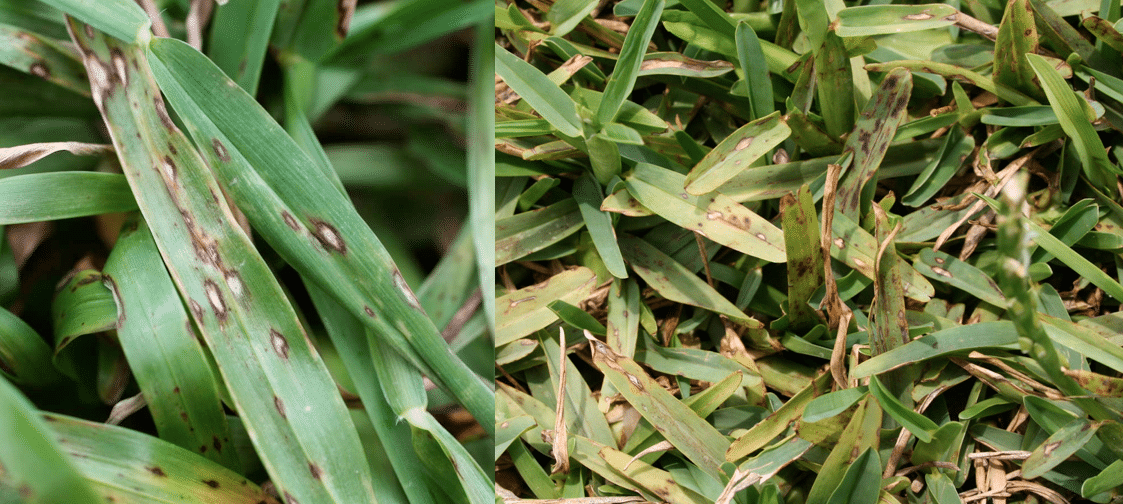By Alfredo Martinez
Gray Leaf Spot

Figure 1 (left) and 2 (right). Gray leaf spot on St. Augustinegrass (images by Alfredo Martinez)
Gray leaf spot (Figure 2) is a fungal disease that affects St. Augustinegrass, perennial ryegrass and tall fescue in Georgia. The disease is particularly aggressive in St Augustinegrass. Hot, humid summer weather and high nitrogen levels can make turf susceptible to this disease. The fungus causing the disease is Pyricularia grisea.
Symptoms: The symptoms of gray leaf spot vary depending on the grass cultivar. On St. Augustinegrass, gray leaf spot first appears as small, brown spots on the leaves and stems. The spots quickly enlarge to approximately ¼ inch in length and become bluish-gray and oval or elongated in shape. The mature lesions are tan to gray and have depressed centers with irregular margins that are purple to brown. A yellow border on the lesions can also occur. In cool-season turfgrass, the symptoms are similar to those of melting out.
Conditions Favoring Disease: Gray leaf spot is favored by daytime temperatures between 80ºF to 90ºF and night temperatures above 65ºF. It is also found in areas with high nitrogen levels and that are stressed by various factors, including drought and soil compaction. This disease is most severe during extended hot, rainy and humid periods.
Disease Management Tips: Management practices that minimize stress and avoid rapid flushes of lush growth during the rainy season lessen the likelihood that severe gray leaf spot symptoms will develop. If irrigation is used to supplement inadequate rainfall, water infrequently but deeply.
Proper irrigation regimens should protect against symptoms of drought stress without increasing disease pressure by extending periods of leaf wetness. Excessive soil moisture and leaf wetness promote gray leaf spot. Irrigating in the late afternoon or evening should be avoided, as this prolongs periods of leaf wetness.
Proper mowing practices are most important for gray leaf spot management in St. Augustinegrass. This grass must frequently be mowed during the summer months to remove excess leaf tissue and keep the canopy open and dry. Mow the turf at the correct height for the designated turfgrass species and remove only one-third of the leaf blade per mowing. Collecting clippings reduces the spread of the disease when gray leaf spot symptoms are evident. Thatch layers should be removed if they are greater than 1 inch in depth.
St. Augustinegrass is especially sensitive to some herbicides. If possible, manage weeds using cultural management techniques and minimal amounts of herbicides. The timing of any atrazine application should be chosen carefully, as this herbicide can stress the grass, especially when temperatures may climb above 85 degrees F. Atrazine applications made before or during disease-favorable conditions increase the likelihood of severe gray leaf spot symptom development. Spot-treating trouble areas with the herbicide may also be considered. Herbicides should always be applied according to the label instruction
Fungicides are available to control the disease. Consult the current Georgia Pest Management Handbook — www.ent.uga.edu/pmh/.
- Brown Patch and Pythium Blight - July 22, 2018
- Gray Leaf Spot - July 22, 2018
- Gray Leaf Spot in Turf - September 24, 2013